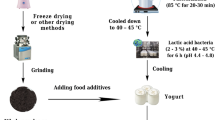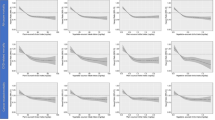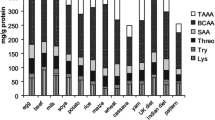Abstract
Consumption of yerba mate occurs mostly in the form of hot infusion (chimarrão). Water solubility of elements found in commercialized yerba mate is needed to establish nutritional value and risks associated with potentially toxic elements. In this study, yerba mate products marketed in three Brazilian states (Paraná, Santa Catarina, and Rio Grande do Sul) for chimarrão were analyzed. Total (dry product) and hot water-soluble concentrations of Al, As, B, Ba, Ca, Cd, Co, Cs, Cu, Fe, K, Li, Mg, Mn, Mo, Ni, P, Pb, Rb, S, Se, Sr, Ti, V, and Zn were determined by inductively coupled plasma mass spectroscopy (ICP–MS). Total concentrations of the ten top elements followed the order of K>Ca>Mg>Mn>P>S>Al>Fe>Ba>Zn. The most soluble elements were B, Cs, Ni, Rb, and K, with values greater than 80%. The lowest water-soluble elements were V, Fe, and Ti (values <10%), followed by Ba, Cd, Al, As, Sr, Ca, and Pb with solubility between 10 and 20%. Although total Cd levels in yerba mate products were often above those permitted by South America legislation, estimated daily consumption intake indicated no risk associated with the chimarrão beverage. Manganese was the micronutrient with the highest total and soluble levels in yerba mate, which surpassed recommended daily intake values when considering a consumption amount of 50 g day−1 of yerba mate as chimarrão. The consumption of yerba mate is safe and contributes to intake of nutrients. The Cd and Pb reference values of yerba mate products sold in South America should be revised.


Similar content being viewed by others
Data Availability
All data generated or analyzed during this study are included in this published article (and its supplementary information files).
Code Availability
Not applicable.
References
Moreira-Souza M, Cardoso EJBN (2002) Dependência micorrízica de Araucaria angustifolia (Bert.) O. Ktze. sob doses de fósforo. Rev Bras Ciência do Solo 26:905–912. https://doi.org/10.1590/S0100-06832002000400007
Heck CI, de Mejia EG (2007) Yerba mate tea (Ilex paraguariensis): a comprehensive review on chemistry, health implications, and technological considerations. J Food Sci 72:R138–R151. https://doi.org/10.1111/j.1750-3841.2007.00535.x
Cardozo Junior EL, Morand C (2016) Interest of mate (Ilex paraguariensis A. St.-Hil.) as a new natural functional food to preserve human cardiovascular health – a review. J Funct Foods 21:440–454. https://doi.org/10.1016/j.jff.2015.12.010
IBGE IB de G e E (2019) Produção Agrícola Municipal. https://www.ibge.gov.br/estatisticas/economicas/agricultura-e-pecuaria/9117-producao-agricola-municipal-culturas-temporarias-e-permanentes.html?=&t=resultados. Accessed 16 Nov 2020
PARANÁ Agência de notícias do Paraná (2020) Maior Produção do País, erva mate envolve 100 mil famílias no Paraná. http://www.aen.pr.gov.br/modules/noticias/article.php?storyid=104046&tit=Maior-producao-do-Pais-erva-mate-envolve-100-mil-familias-no-Parana-. Accessed 20 Apr 2020
Valduga AT, Gonçalves IL, Magri E, Delalibera Finzer JR (2019b) Chemistry, pharmacology and new trends in traditional functional and medicinal beverages. Food Res Int 120:478–503. https://doi.org/10.1016/j.foodres.2018.10.091
Heinrichs R, Malavolta E (2001) Composição mineral do produto comercial da erva-mate (Ilex paraguariensis St. Hil.). Ciência Rural 31:781–785. https://doi.org/10.1590/S0103-84782001000500007
Giulian R, Iochims dos Santos CE, de Moraes SS et al (2009) The study of the influence of industrial processing on the elemental composition of mate tealeaves (Ilex paraguariensis) using the PIXE technique. LWT - Food Sci Technol 42:74–80. https://doi.org/10.1016/j.lwt.2008.05.007
Pozebon D, Dressler VL, Marcelo MCA, de Oliveira TC, Ferrão MF (2015) Toxic and nutrient elements in yerba mate (Ilex paraguariensis). Food Addit Contam Part B 8:215–220. https://doi.org/10.1080/19393210.2015.1053420
Barbosa JZ, Motta ACV, dos Reis AR, Corrêa RS, Prior SA (2020) Spatial distribution of structural elements in leaves of Ilex paraguariensis: physiological and ecological implications. Trees 34:101–110
Motta ACV, Barbosa JZ, Magri E, Pedreira GQ, Santin D, Prior SA, Consalter R, Young SD, Broadley MR, Benedetti EL (2020) Elemental composition of yerba mate (Ilex paraguariensis A.St.-Hil.) under low input systems of southern Brazil. Sci Total Environ 736:139637. https://doi.org/10.1016/j.scitotenv.2020.139637
Barbosa JZ, Motta ACV, Consalter R et al (2018) Plant growth, nutrients and potentially toxic elements in leaves of yerba mate clones in response to phosphorus in acid soils. An Acad Bras Cienc 90:557–571. https://doi.org/10.1590/0001-3765201820160701
Jacques RA, Arruda EJ, de Oliveira LCS, de Oliveira AP, Dariva C, de Oliveira JV, Caramão EB (2007) Influence of agronomic variables on the macronutrient and micronutrient contents and thermal behavior of mate tea leaves (Ilex paraguariensis). J Agric Food Chem 55:7510–7516. https://doi.org/10.1021/jf071545g
Magri E, Gugelmin EK, Grabarski FAP et al (2020) Manganese hyperaccumulation capacity of Ilex paraguariensis A.St. Hil. and occurrence of interveinal chlorosis induced by transient toxicity. Ecotoxicol Environ Saf 203:111010. https://doi.org/10.1016/j.ecoenv.2020.111010
Diário Oficial da União (DOU) Resolução da Diretoria Colegiada. Brasil
Milani RF, Silvestre LK, Morgano MA, Cadore S (2019) Investigation of twelve trace elements in herbal tea commercialized in Brazil. J Trace Elem Med Biol 52:111–117. https://doi.org/10.1016/j.jtemb.2018.12.004
Valduga AT, Gonçalves IL, Magri E (2019a) Analysis of the presence of toxic metals in yerba mate samples: a case study from South Brazil. Water Air Soil Pollut 230:153. https://doi.org/10.1007/s11270-019-4204-z
Magri E, Valduga AT, Gonçalves IL et al (2021) Cadmium and lead concentrations in yerba mate leaves from agroforestry and plantation systems: an international survey in South America. J Food Compos Anal 103702. https://doi.org/10.1016/j.jfca.2020.103702
Frigo C, Magri E, Barbosa JZ, Sarteretto LM, Araujo EM, Melo VF, Prior SA, Motta ACV (2020) Influence of roadways on heavy metal content in soils and yerba mate tissue in southern Brazil. Manag Environ Qual 31:1477–1495. https://doi.org/10.1108/MEQ-10-2019-0219
Barbosa JZ, Zambon LM, Motta ACV, Wendling I (2015) Composition, hot-water solubility of elements and nutritional value of fruits and leaves of yerba mate. Ciênc Agrotec 39:593–603. https://doi.org/10.1590/S1413-70542015000600006
Han W-Y, Zhao F-J, Shi Y-Z, Ma LF, Ruan JY (2006) Scale and causes of lead contamination in Chinese tea. Environ Pollut 139:125–132. https://doi.org/10.1016/j.envpol.2005.04.025
Škrbić B, Cvejanov J (2011) The enrichment of wheat cookies with high-oleic sunflower seed and hull-less barley flour: impact on nutritional composition, content of heavy elements and physical properties. Food Chem 124:1416–1422. https://doi.org/10.1016/j.foodchem.2010.07.101
Maiocchi MG, Del Vitto LA, Petenatti ME et al (2016) Multielemental composition and nutritional value of “dumosa” (Ilex dumosa), “yerba mate” (I. paraguariensis) and their commercial mixture in different forms of use. Rev la Fac Ciencias Agrar 48:145–159
Olivari I, Paz S, Gutiérrez ÁJ, González-Weller D, Hardisson A, Sagratini G, Rubio C (2020) Macroelement, trace element, and toxic metal levels in leaves and infusions of yerba mate (Ilex paraguariensis). Environ Sci Pollut Res 27:21341–21352. https://doi.org/10.1007/s11356-020-08681-9
Dalipi R, Borgese L, Tsuji K, Bontempi E, Depero LE (2018) Elemental analysis of teas, herbs and their infusions by means of total reflection X-ray fluorescence. J Food Compos Anal 67:128–134. https://doi.org/10.1016/j.jfca.2018.01.010
Pohl P, Bielawska-Pohl A, Dzimitrowicz A, Greda K, Jamroz P, Lesniewicz A, Szymczycha-Madejaa A, Welnaa M (2018) Understanding element composition of medicinal plants used in herbalism-a case study by analytical atomic spectrometry. J Pharmaceut Biomed 159:262–271. https://doi.org/10.1016/j.jpba.2018.06.017
Gezgin, S; Özcan, MM.; Atalay, E. Determination of minerals extracted from several commercial teas (Camellia sinensis) to hot water (infusion). Journal Of Medicinal Food, [S.L.], v. 9, n. 1, p. 123-127, mar. 2006. Mary Ann Liebert Inc. https://doi.org/10.1089/jmf.2006.9.123
WHO. World Health Organization (1996) Trace elements in human nutrition and health. WHO Library, Geneva
Institute of Medicine (IOM) (2006) Dietary reference intakes. National Academies Press, Washington, D.C.
SCHER - Scientific Committee on Health and Environmental Risks (2012) Assessment of the tolerable daily intake of barium. Brussels
Food Standards Agency (FSA) (2003) Safe upper levels for vitamins and minerals. United Kingdom
Seńczuk W (2006) Toksykologia wspolczesna. PZWL
Team RC (2014) A language and environment for statistical computing.
Millaleo R, Reyes-Diaz M, Ivanov A et al (2010) Manganese as essential and toxic element for plants: transport, accumulation and resistance mechanisms. J Soil Sci Plant Nutr 10:470–481. https://doi.org/10.4067/S0718-95162010000200008
Toppel FV, Junior AM, Motta ACV, Frigo C, Magri E, Barbosa JZ (2018) Soil chemical attributes and their influence on elemental composition of yerba mate leaves. Floresta 48:425–434. https://doi.org/10.5380/rf.v48i3.56677
Santos LMG dos, Vicentini Neto SA, Iozzi G, Jacob S do C (2017) Arsenic, cadmium and lead concentrations in Yerba mate commercialized in Southern Brazil by inductively coupled plasma mass spectrometry. Ciência Rural 47:e2170202. https://doi.org/10.1590/0103-8478cr20170202
Islam MA, Ebihara M (2017) Elemental characterization of Japanese green tea leaves and tea infusion residue by neutron-induced prompt and delayed gamma-ray analysis. Arab J Chem 10:S677–S682. https://doi.org/10.1016/j.arabjc.2012.11.008
Taiz L, Zeiger E, Møller IM, Murphy A (2015) Plant physiology and development, 6th edn. Sinauer Associates, New York, United States
Amarillo Caniza DA, Turatti AM, Fernandes F, Ferraz Dias J, Iochims Dos Santos CE (2020) Geochemical markers of Ilex paraguariensis determined by PIXE. Nucl Instrum Meth B 477:163–168. https://doi.org/10.1016/j.nimb.2019.10.015
Wróbel K, Wróbel K, Urbina EMC (2000) Determination of total aluminum, chromium, copper, iron, manganese, and nickel and their fractions leached to the infusions of black tea, green tea, Hibiscus sabdariffa, and Ilex paraguariensis (mate) by ETA-AAS. Biol Trace Elem Res 78(1-3):271–280. https://doi.org/10.1385/BTER:78:1-3:271
Bragança, VLC; Melnikov, P; Zanoni, LZ. Trace elements in different brands of yerba mate tea. Biological Trace Element Research, [S.L.], v. 144, n. 1-3, p. 1197-1204, 13 abr. 2011. Springer Science and Business Media LLC. https://doi.org/10.1007/s12011-011-9056-3
Kabata-Pendias A (2010) Trace elements in soils, 4th edn. John Wiley & Sons, Ltd, Chichester, UK
Zhang J, Yang R, Chen R, Peng Y, Wen X, Gao L (2018) Accumulation of heavy metals in tea leaves and potential health risk assessment: a case study from Puan County, Guizhou Province, China. Int J Environ Res Public Health 15:133. https://doi.org/10.3390/ijerph15010133
de Oliveira LM, Das S, da Silva EB, Gao P, Gress J, Liu Y, Ma LQ (2018) Metal concentrations in traditional and herbal teas and their potential risks to human health. Science of the Total Environment 633:649–657. https://doi.org/10.1016/j.scitotenv.2018.03.215
Nunes JA, Batista BL, Rodrigues JL, Caldas NM, Neto JAG, Barbosa F Jr (2010) A simple method based on ICP-MS for estimation of background levels of arsenic, cadmium, copper, manganese, nickel, lead, and selenium in blood of the Brazilian population. J Toxicol Environ Heal Part A 73:878–887. https://doi.org/10.1080/15287391003744807
Hope S-J, Daniel K, Gleason KL, Comber S, Nelson M, Powell JJ (2006) Influence of tea drinking on manganese intake, manganese status and leucocyte expression of MnSOD and cytosolic aminopeptidase P. Eur J Clin Nutr 60:1–8. https://doi.org/10.1038/sj.ejcn.1602260
Maccari A Jr, de Queiroz MR, Roncato Maccari DBL, Rucker NGA (2006) Indústria ervateira no estado do Paraná II–Fornecimento de matéria-prima. Rev Acadêmica Ciência Anim 4:63. https://doi.org/10.7213/cienciaanimal.v4i1.9285
Greff HP, de Farias JA, de Souza PD (2020) Description of the Mate Industrial Agglomerate of the Alto Vale Taquari, Rio Grande do Sul, Brazil. Floresta Ambient 27:e20180137. https://doi.org/10.1590/2179-8087.013718
Acknowledgements
The authors thank the University of Nottingham laboratory staff Lolita Wilson and Saul Vazquez Reina for analytical support. ACVM is grateful to the National Council for Scientific and Technological Development (CNPq) for financial support (Grant Numbers 99999.001631/2015-02 and 306908/2016-6) and to Coordination for the Improvement of Higher Education Personnel (CAPES) for scholarship support.
Funding
This study was funded by the National Council for Scientific and Technological Development (CNPq) (Grant Numbers 99999.001631/2015-02 and 306908/2016-6) and to Coordination for the Improvement of Higher Education Personnel (CAPES).
Author information
Authors and Affiliations
Contributions
Nayara Caroline Majewski Ulbrich: writing (original draft), conceptualization, methodology, and investigation. Luciane Lemos do Prado: writing (review and editing), conceptualization, methodology, and investigation. Julierme Zimmer Barbosa: writing (review and editing), conceptualization, and investigation. Eloá Moura Araujo: review and editing, software, and formal analysis. Giovana Poggere: writing—review and editing. Antônio Carlos Vargas Motta: writing (review and editing), conceptualization, methodology, and investigation. Stephen A. Prior: writing (review and editing) and investigation. Ederlan Magri: writing (review and editing), conceptualization, methodology, and investigation. Scott D. Young: writing (review and editing) and investigation. Martin R. Broadley: writing (review and editing) and investigation.
Corresponding author
Ethics declarations
Ethics approval
Not applicable.
Consent to participate
Not applicable.
Consent for publication
Not applicable.
Conflict of Interest
The authors declare no competing interests.
Additional information
Publisher’s Note
Springer Nature remains neutral with regard to jurisdictional claims in published maps and institutional affiliations.
Supplementary Information
ESM 1
(DOCX 26 kb)
Rights and permissions
About this article
Cite this article
Ulbrich, N.C.M., do Prado, L.L., Barbosa, J.Z. et al. Multi-elemental Analysis and Health Risk Assessment of Commercial Yerba Mate from Brazil. Biol Trace Elem Res 200, 1455–1463 (2022). https://doi.org/10.1007/s12011-021-02736-9
Received:
Accepted:
Published:
Issue Date:
DOI: https://doi.org/10.1007/s12011-021-02736-9




